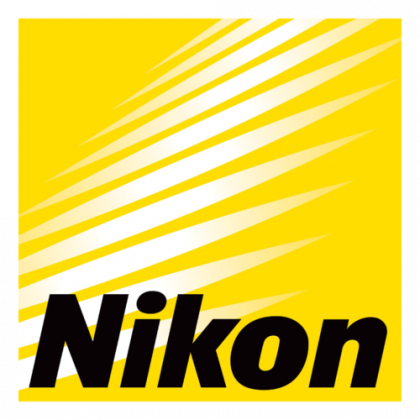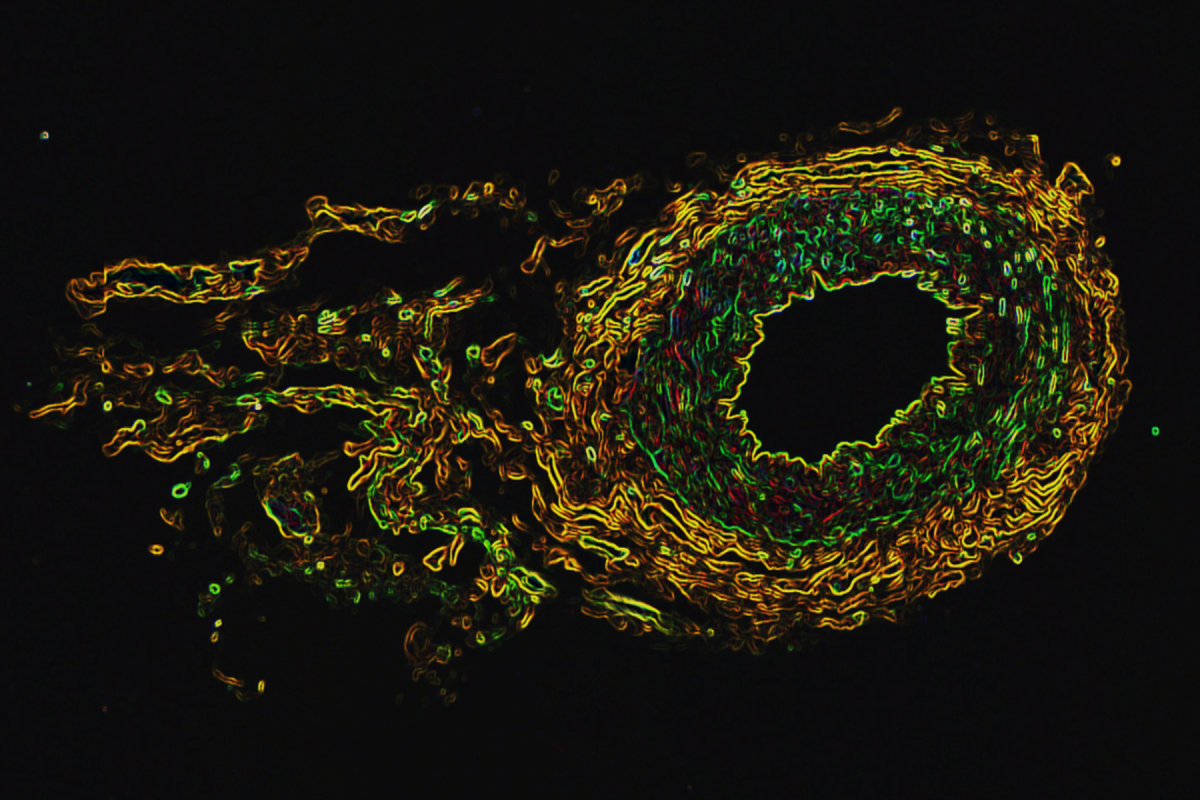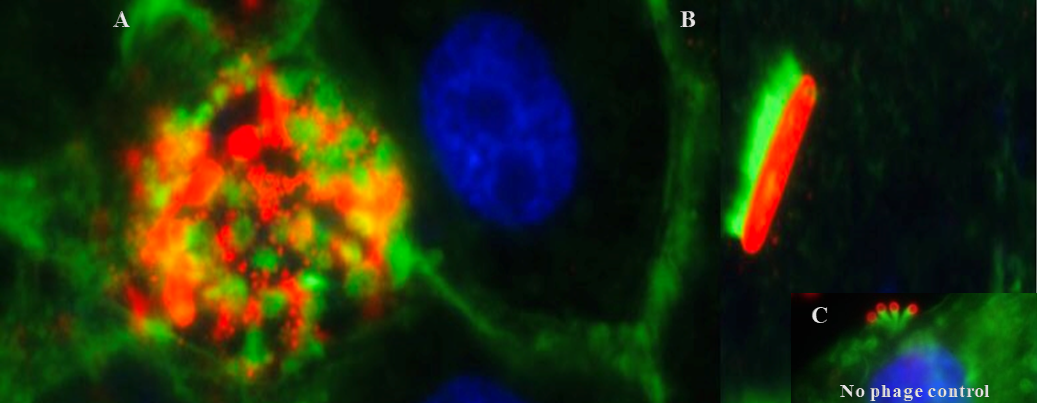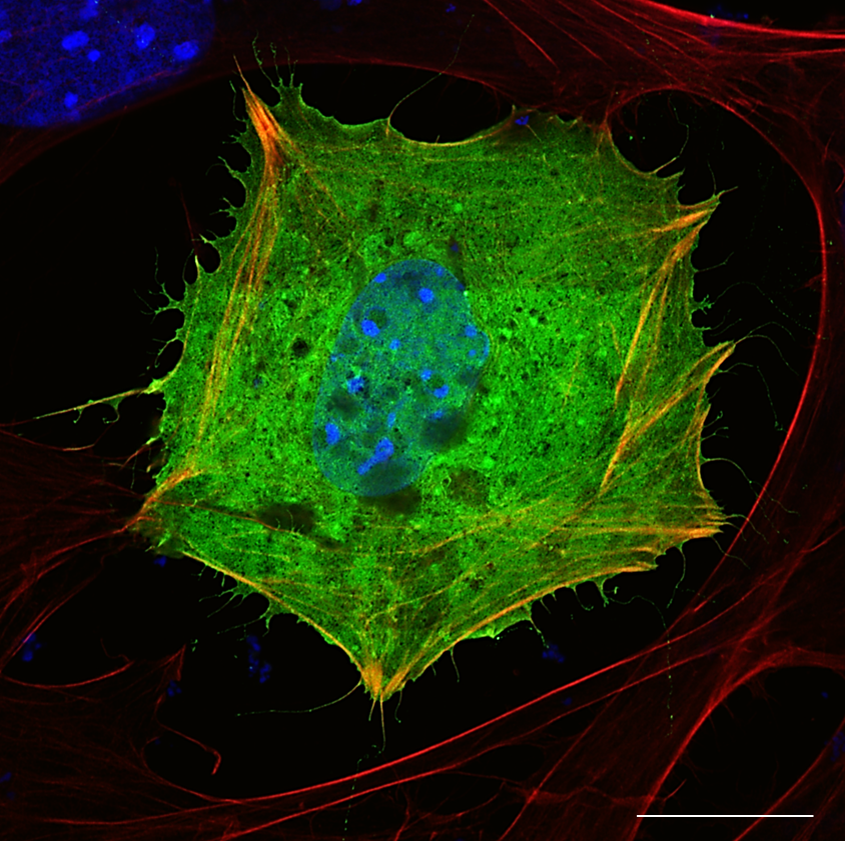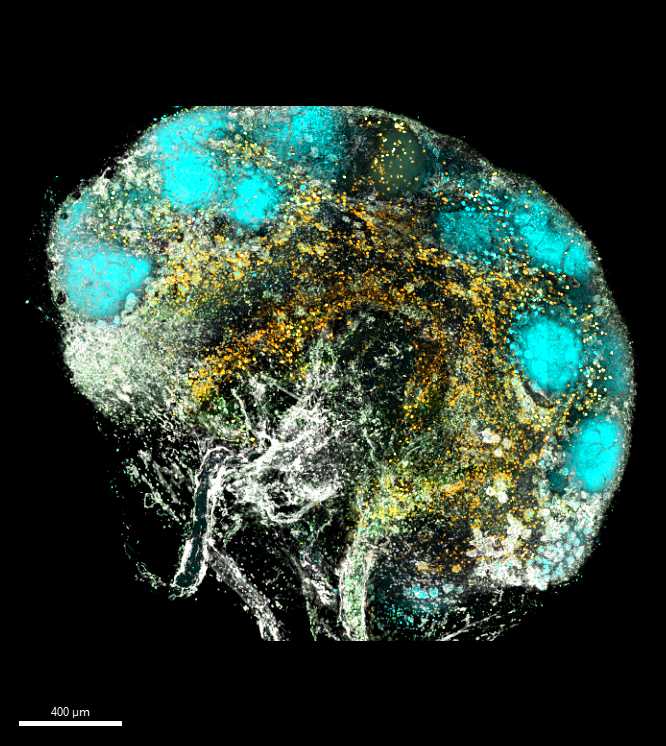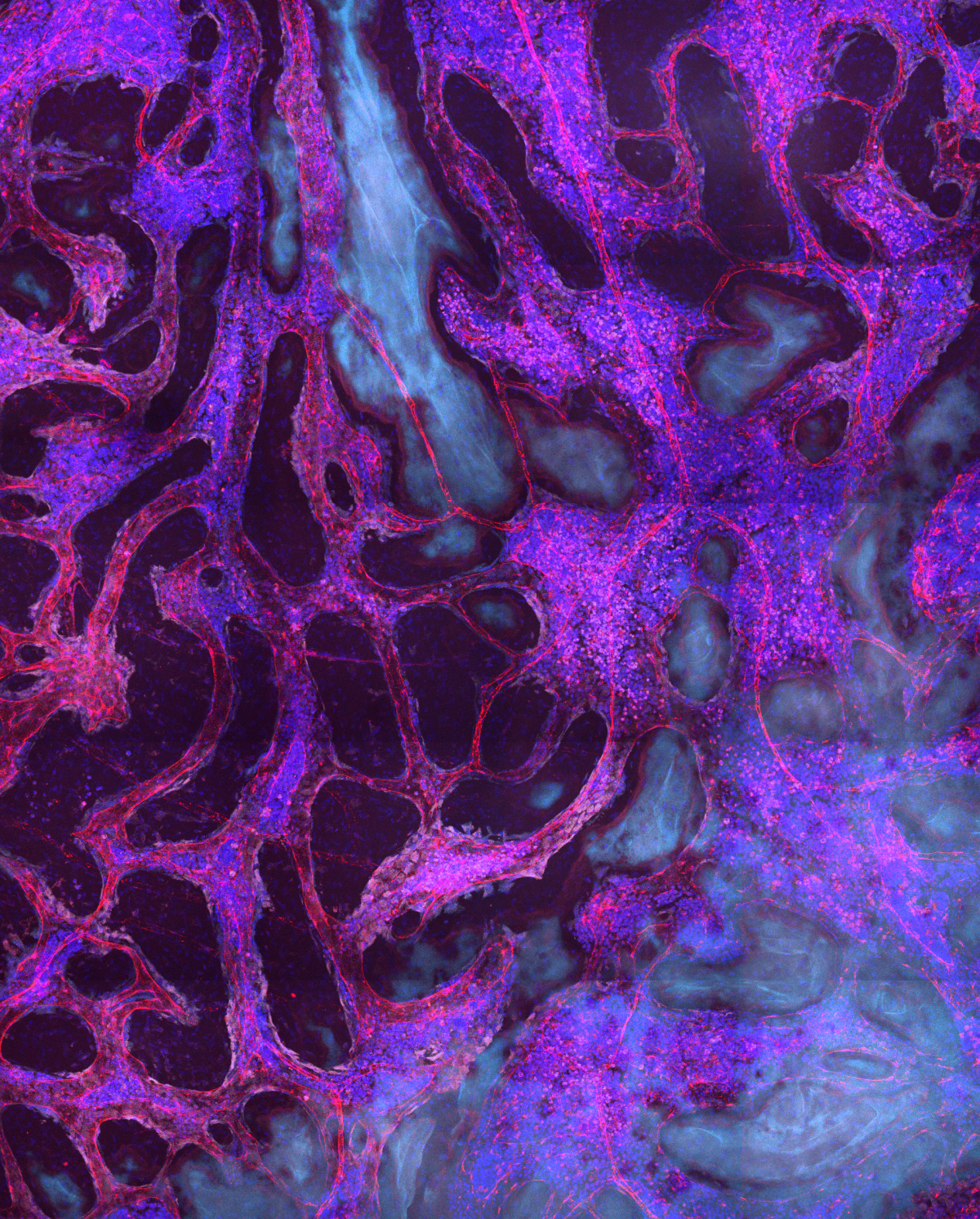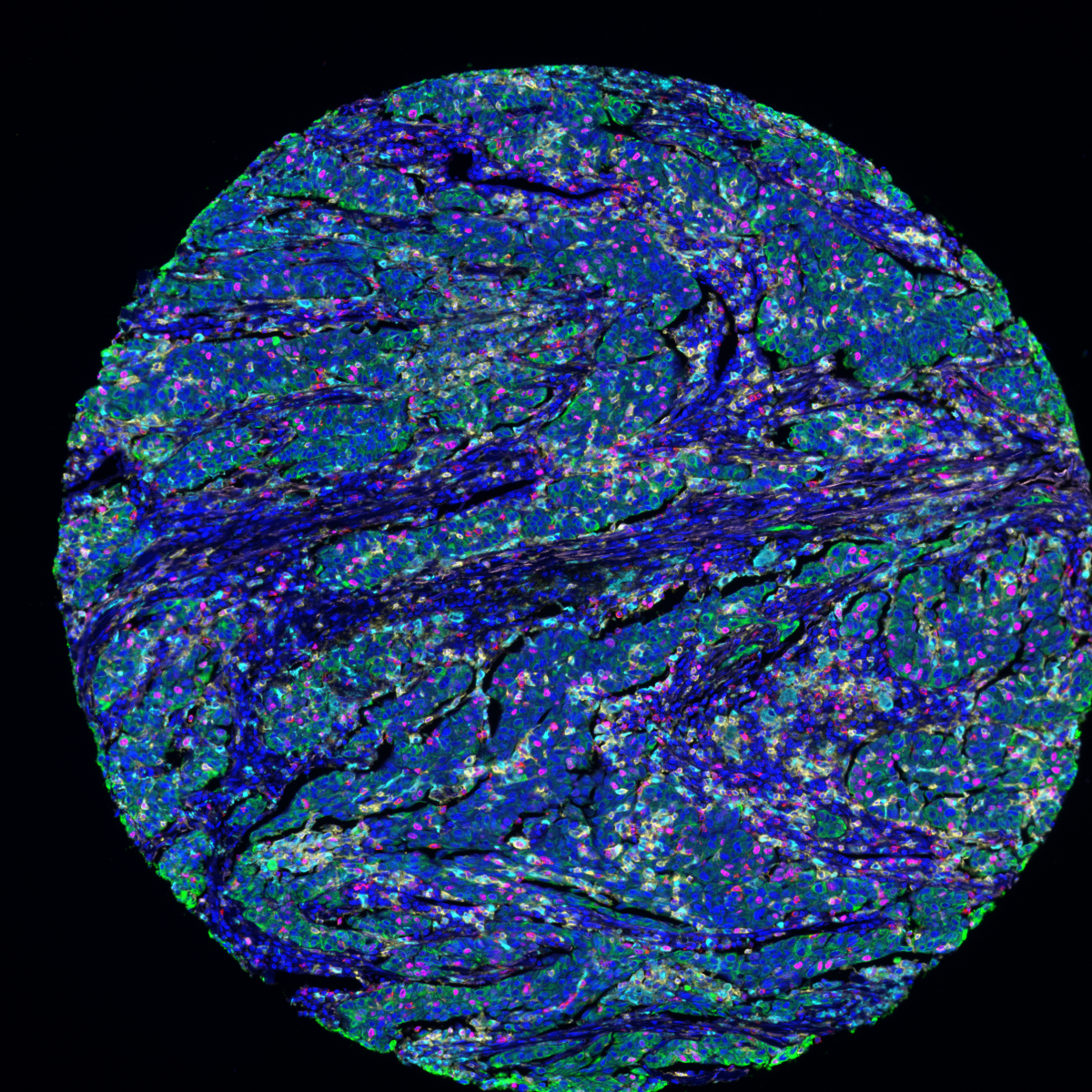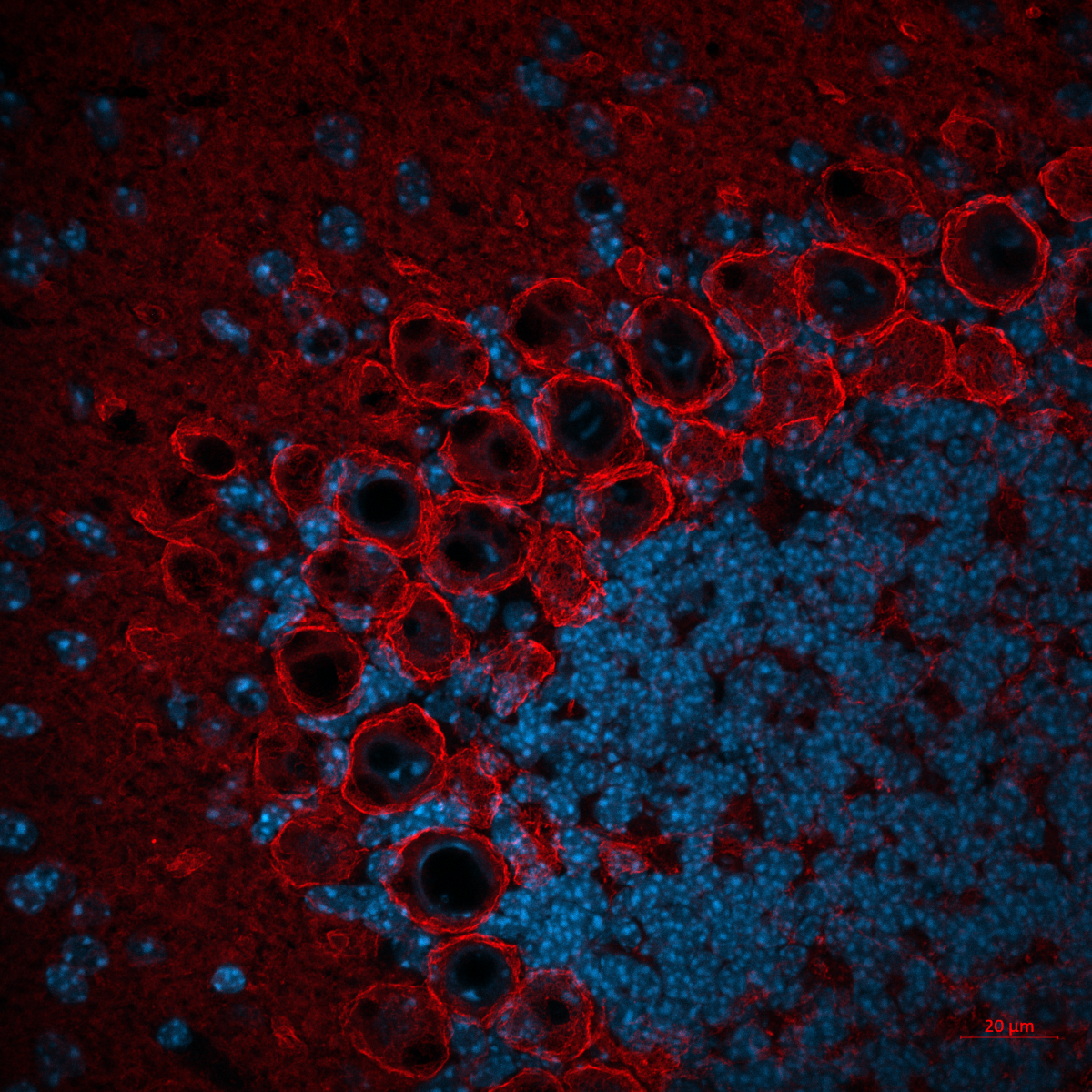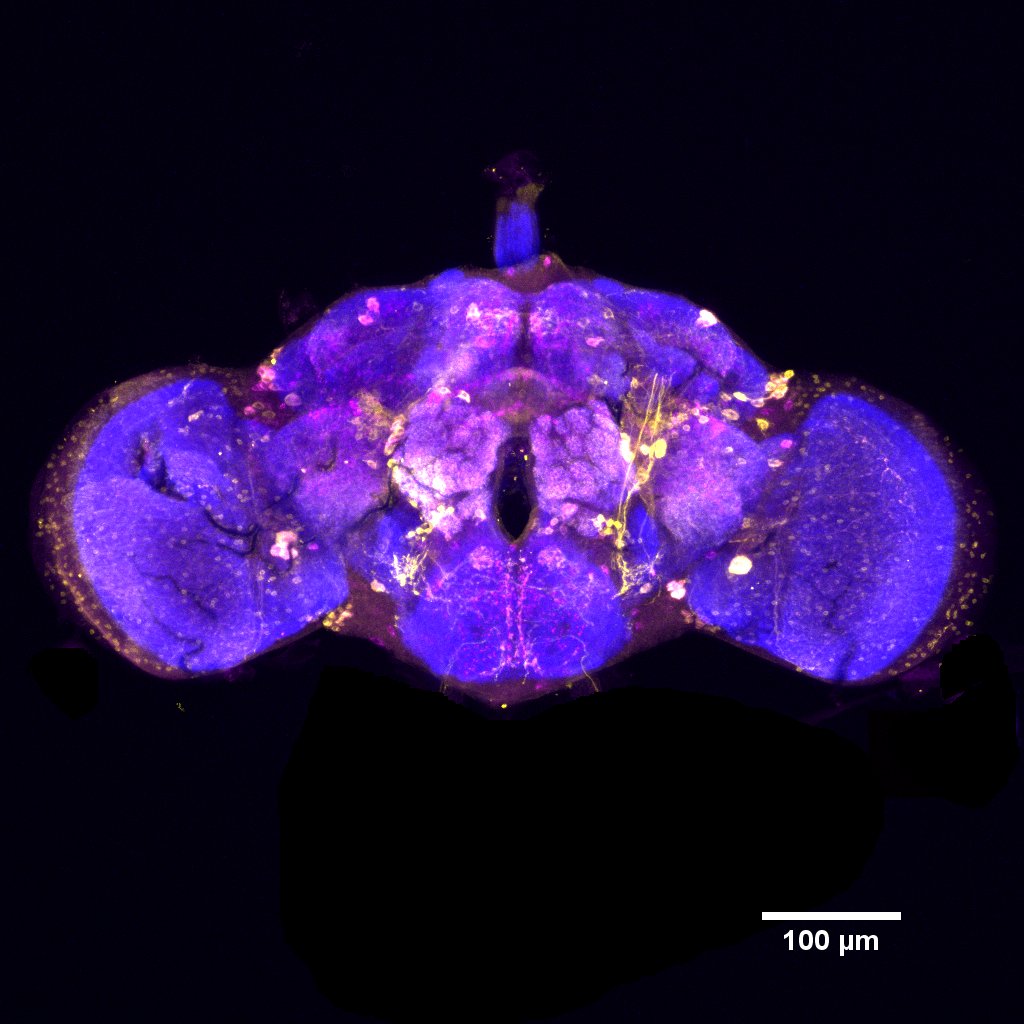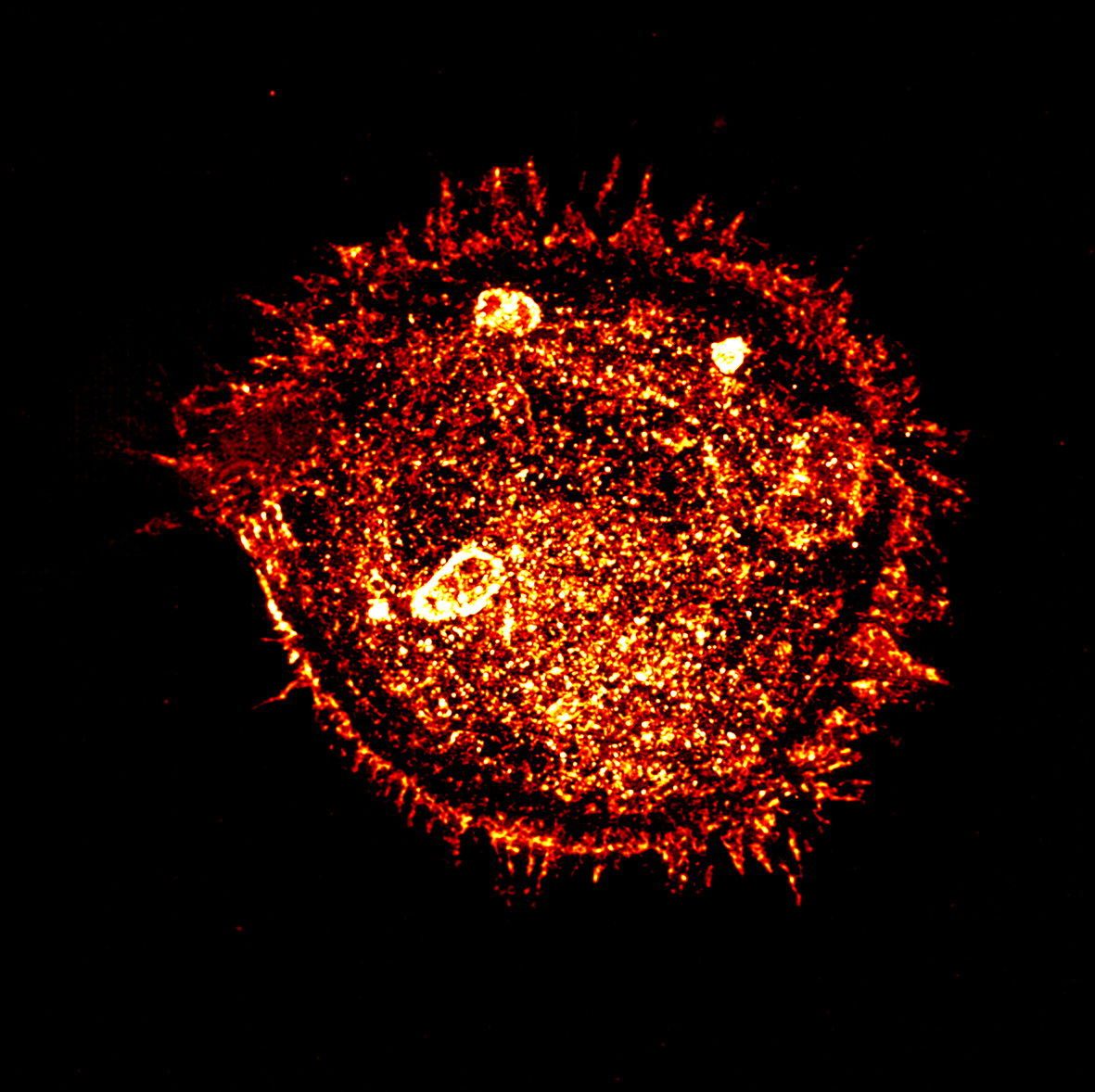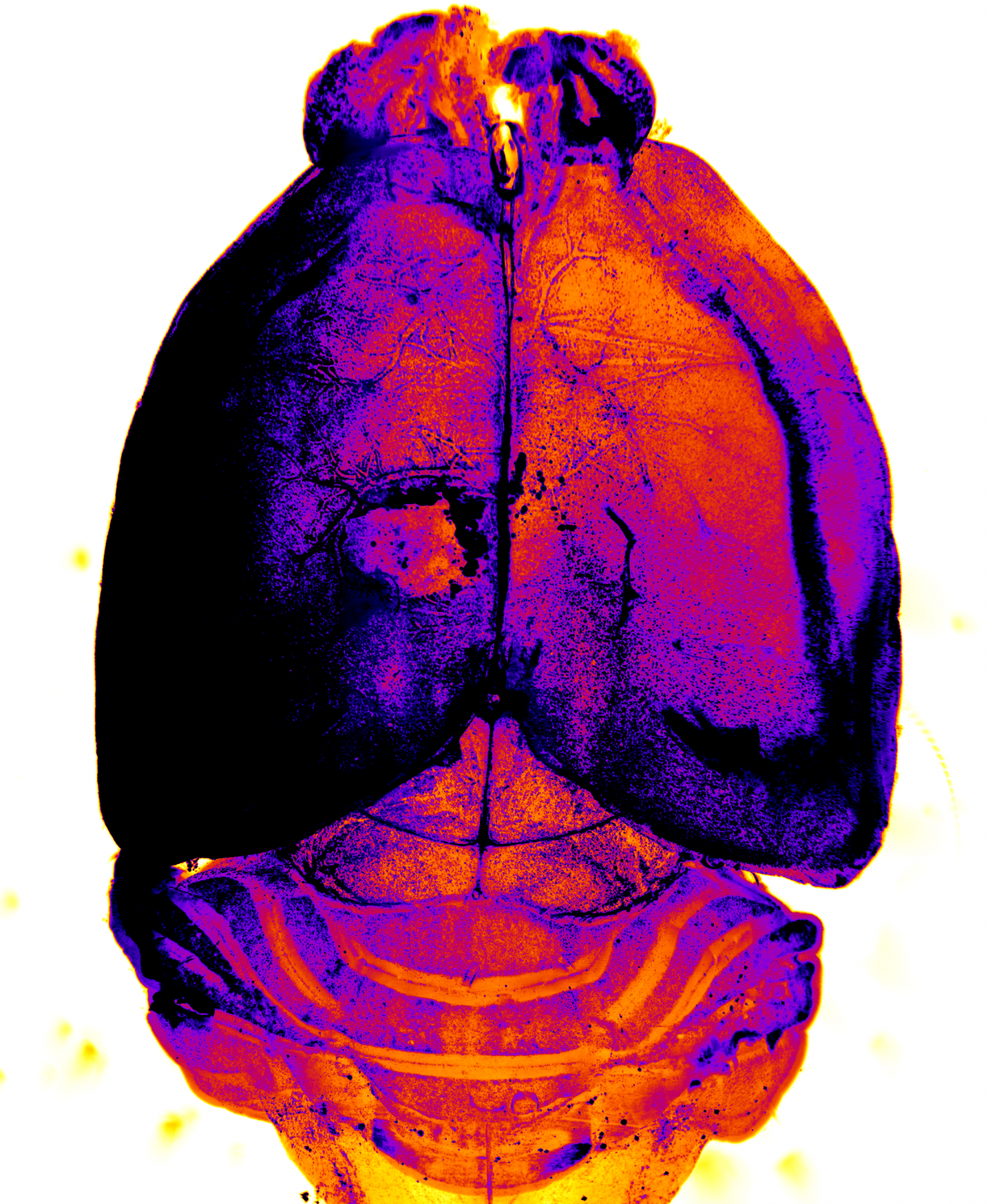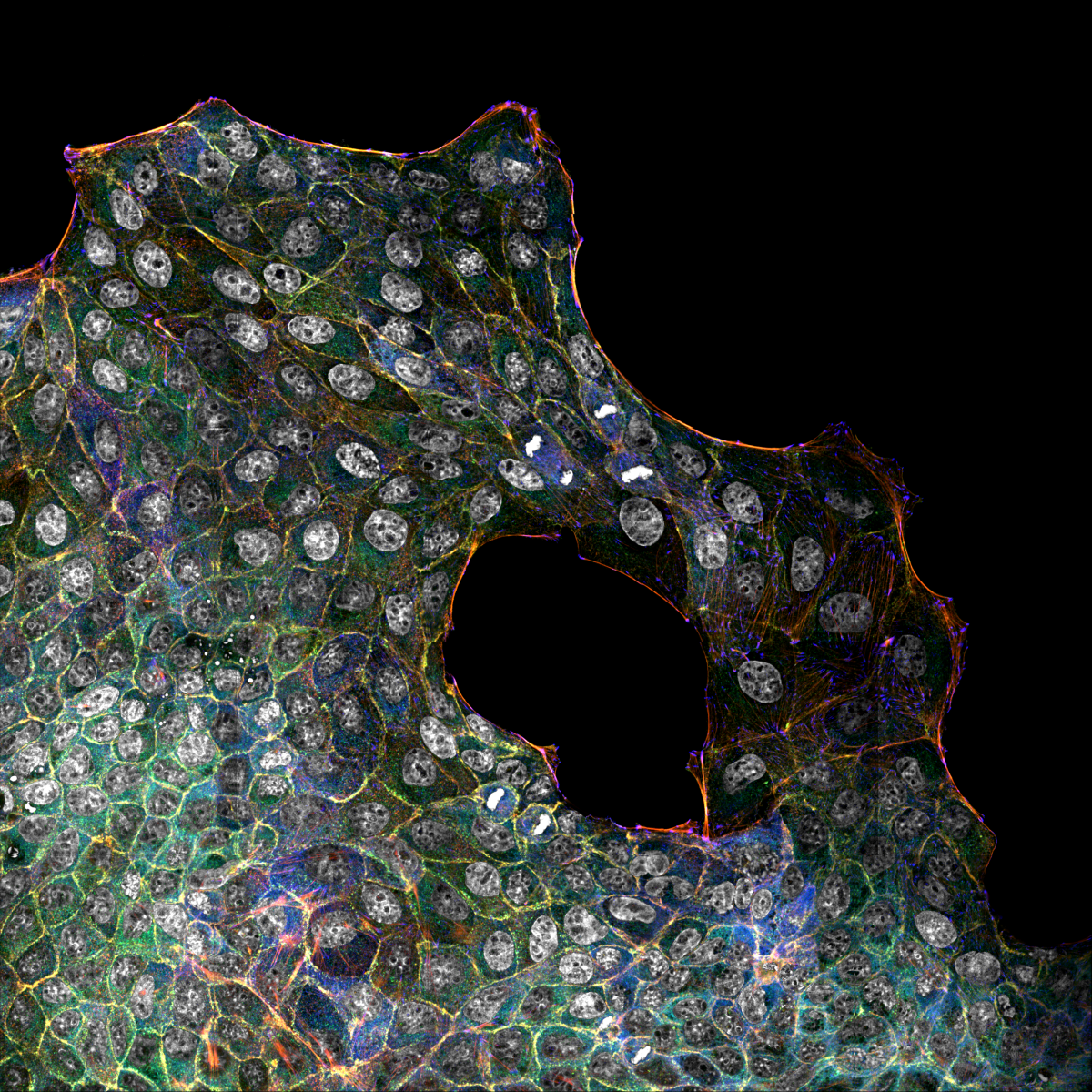SMS 2022 Image Competition
Images of Research
Well done to Dr Karla Neves, a Research Associate at the University of Glasgow – BHF Cardiovascular Research Centre, for their winning entry of ‘Blood Vessel Comet’. Karla won the £50 prize
Winner: Blood Vessel Comet
Dr Karla Neves, University of Glasgow
In the image, we have a human blood vessel isolated from gluteal biopsies. In the centre, you see the lumen of the vessel (black hole), where the blood flows through, which is surrounded by endothelial cells captured in yellow. Glowing in green we have the smooth muscle cells that are responsible for the vessel to widen and narrow. And finally, the outer yellow layer represents the adventitia, which is composed of fibroblasts, nerve fibers and other components. Our research aims to understand why blood vessels do not function properly in people with high blood pressure. We hope to understand the biological mechanisms underpinning dysfunctional blood vessels to also help scientists discover new drug targets to better treat high blood pressure.
Competition Entries
1. Blood Vessel Comet
Dr Karla Neves, University of Glasgow
In the image, we have a human blood vessel isolated from gluteal biopsies. In the centre, you see the lumen of the vessel (black hole), where the blood flows through, which is surrounded by endothelial cells captured in yellow. Glowing in green we have the smooth muscle cells that are responsible for the vessel to widen and narrow. And finally, the outer yellow layer represents the adventitia, which is composed of fibroblasts, nerve fibers and other components. Our research aims to understand why blood vessels do not function properly in people with high blood pressure. We hope to understand the biological mechanisms underpinning dysfunctional blood vessels to also help scientists discover new drug targets to better treat high blood pressure.
2. Killing colonized E.coli O157 on bovine embryonic lung cells with phages
Asim Ullah, Roslin Institute, University of Edinburgh
This image is the combination of two separate images which were captured with fluorescent microscope of Roslin bioimaging facility at 100X magnification. The image demonstrates, E.coli O157 (Alexa flour-568: red) colonization on EBL cells by forming a pedestal beneath (bright green) itself as shown in the image as result of effector proteins translocation inside the EBL cells. These effector proteins results in cytoskeleton rearrangement and thus actin filament(pedestal) or attaching and effacing (A/E) lesion formation. For F-actin cytoskeleton, Flash phalloidin green 488 was used, while nuclei of the EBL cells were stained with Hoescht 33342 shown in violet colour. In this particular image, (A) represent, phage susceptible E.coli O157 which are killed by the phages (viruses of bacteria which are extensively under investigation to be used as antibiotic alternative). The killing is clearly evident by the red clumps of E.coli O157 while the (B) was a bacteria spotted showing resistance against phage and has increased its size significantly. This morphology is supported by literature as bacteria induce SOS response to stop cell division in any alarming situation and thus grow larger in size to produce filaments. The same strategy is likely to be adopted by the bacteria here to evade phage killing. (c) shows normal colonized E.coli O157 without phage as a proof of justification for the above two morphologies.
3. Cellular Constellations
Charlotte Clews, The Roslin Institute, University of Edinburgh
Osteoblast cell line transfected with fluorescent PHOSPHO1-mNeonGreen fusion construct, and stained for actin (phalloidin594) and Hoescht. This shows the activity of PHOSPHO1 within the cell, and at peripheral cellular projections where actin also appears to be present. Small, vesicle sized objects appear to be present in the ECM, originating from these projections, and may be the first fluorescent evidence of matrix vesicles in cell cultures. Scale bar = 15 microns.
4. The World
Dr Chiara Pirillo, Cancer Research UK Beatson Institute
Immunofluorescence Ce3D multiplex volume imagine of mouse whole mediastinal lymph node. Tissue was stained for B cells (pale blue), CD31(grey),neutrophil(deep orange), The image was taken using a Zeiss LSM880 confocal microscope with lamba mode
5. Lava Flow
Desiree Zerbst, University of Glasgow
Vascular system in the bone marrow resembling lava flow from an erupting volcano. Mouse bone marrow (calvarium) is highly vascularised (stained for endothelial cells CD31 conjugated to AlexaFluor594, red) and densely packed with cells (nuclei stained with DAPI). Skull bone stained by intravital injection of antibodies into the mouse. Calvarium is then harvested, ex vivo stained with DAPI and chemically cleared. Acquisition was done with a Zeiss LSM 880, 20x objective with spectral detection. Images was processed by linear unmixing and maximum projection of z-stack. Red=CD31+ (endothelial cells) AlexaFluor594 Blue=DAPI (nuclei) Cyan=bone (tissue autofluorescence)
6. The Battlefield
Rachel Pennie, Scientific Officer, CRUL Beatson Institute
IF IHC multiplex panel on our lung adenocarcinoma cohort consisting of: CD4 (opal 570) – yellow CD68 (opal 690) – cyan CD8 (opal 520) – red CKPAN (Opal 620) – green Ki67 (opal 650) – magenta SMA (opal 540) – light pink The image was scanned on the Akoya Vectra Polaris at 20x. We are in the M42 group
7. The Brain Splash
Dr Kseniia Bondarenko, University of Edinburgh
You look at the coronal section of the cerebellum in the mouse brainstem. Big bright cells forming the “splash” are Purkinje neurons essential for motor learning, balance, and coordination of movements. Purkinje neurons form single layers in the cerebellum folds with cells aligned in parallel. A diagonal cut through the fold allows for capturing several rows of Purkinje cells in one plane. Purkinje cells localise to the “top” of the granular layer of the cerebellum fold (here, a mass of granular cell nuclei in blue, Hoechst 33342). They widely express voltage-gated potassium channels Kv3.3 (anti-Kv3.3 + AlexaFluor 594, red), which enable narrow action potential firing of high frequencies, essential for accurate motor coordination. It is also known that mutations in the human Kv3.3 channel can trigger a neurodegenerative disease called spinocerebellar ataxia type 13, inducing Purkinje neuron damage and their eventual death. Thus, we were interested in exploring Kv3.3 expression in the mice strains with affected Kv3.3 subunit (Kv3.3-N483C) and checking for potential changes in the phenotype (and they did show tremors!). Prep: frozen 12 µm sections from a control CBA WT mouse, P20. Maximal intensity projection of a z-stack acquired using Zeiss 980 confocal with 60x objective.
8. Fly Brain
Dr Kseniia Bondarenko, University of Edinburgh
Confocal image of a female Drosophila melanogaster brain, 10x, Zeiss LSM 780 confocal at the Wolfson Wohl. In this image, we are showing in blue a marker for neuropil (alexa 647), nc82, in magenta the expression of DH31(alexa 594) neuropeptide, and in yellow the expression of the driver DH31G4 (alexa 488) In this project, we are trying to understand the connection between gut dysregulations and behaviours like sleep. Inducing gut proliferation through the overexpression of different oncogenes, like Ras, disrupts sleep.The analysis of the expression of different neuropeptides in the brain then allows us to understand and unravel which signaling pathways are being co-opted in the context of tumorigenesis.”
10. Fire
Dr Cristina Martinez Gonzalez
Light-sheet microscopy image of a whole mouse brain immunolabeled against cFOS (Alexa-647) and optically cleared using iDISCO. The animal used had a 50ul kainate injection in the left hippocampus and had a seizure 90 min before perfusion. We imaged the brain with an Ultramicroscope II at 2X magnification in a single field of view. Optical slices were obtained every 4um across 3.2 mm in Z, covering the entire brain. A maximum intensity projection was obtained, a fire LUT was applied then and adjusted for brightness and contrast in FIJI.
11. MDCK wound healing
Dr Jamie Whitelaw, University of the West of Scotland/CRUK Beatson Institute
MDCK cells during a wound healing assay. The cells were tagged with a membrane dye (Red) pre-fixation and then stained, post-fixation with Phalloidin (Green), Vinculin (Blue) and DAPI (White). The image was acquired at the Beatson BAIR facility, using the Zeiss LSM 980 airyscan microscope. Here, we used a combination of Z-stacks and tile scans to generate a large field of view with high resolution using the 40X water objective. This shows cells at the leading edge form more adhesions to the substrate and spread more than those crammed at the back of the dish (bottom left corner).
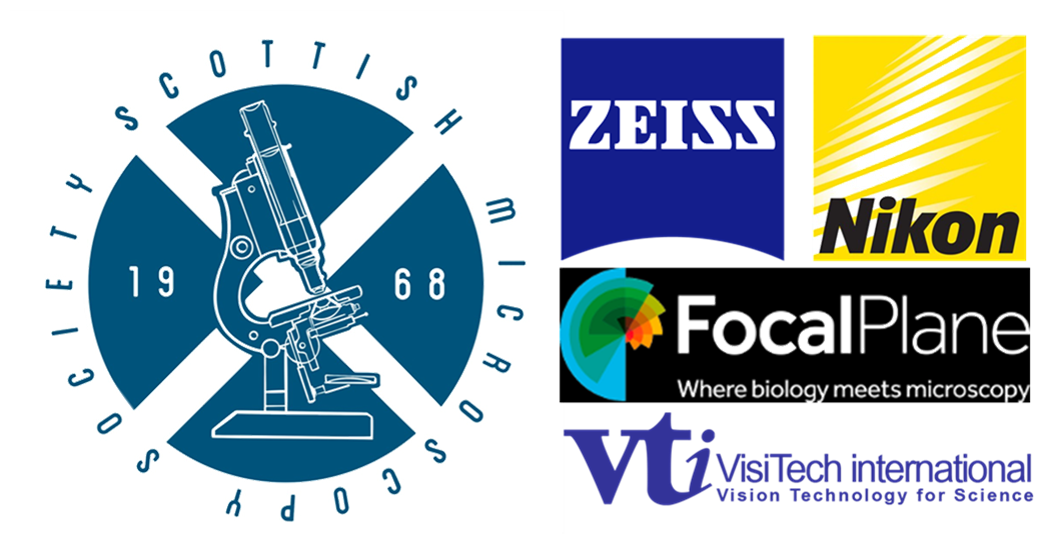
Get in touch with the Scottish Microscopy Society!
Feel free to contact us or join our mailing list using the contact form below.

